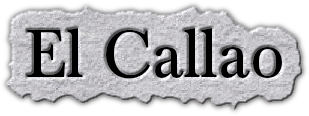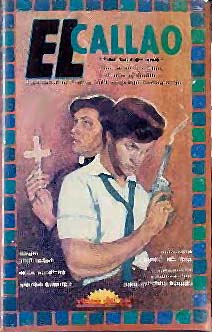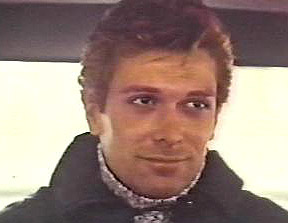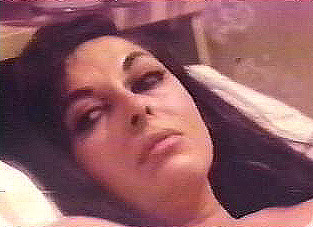
El Callao [The Silent One](1969?) Exec Prod: Bernard Block; Prod: José Antonio Torres; Dir: Glauco del Mar; Scr: José Antonio Torres, Glauco del Mar; Photo: Glen Richard Tracy; Music: Mike Hernández, Valentino; Prod Chief: Raúl Rodríguez; Film Ed: Glen Richard Tracy; Sound: Christ Swan
Cast: José Albar (El Callao; Padre Morán), Olga Agostini (Blanquita), Braulio Castillo (police detective), Angelo Ramírez (El Perfumito), Raúl Rodríguez (El Tecato), José L. Dones (El Mudo), Padre José Balcazar (priest), Roberto Maurano ("private detective" [sic = businessman who is robbed and murdered]), Radamez López (El Gitano [Ramón]), Johnny H. (police officer in West New York), Romero Rochón (bodyguard [Manuel]), Rogelio Hernández (detective), Roger Rubio (uniformed cop), María Tai (wife of El Gitano), Edwin Marcial (gas station man), Diosa Gálvez (woman with drunk), Larry Ramos (drunk), Víctor Torres (policeman outside club), Pablo Ortiz (taxi driver), José I. Colón (spectator), Raúl Soler (Andy, shoeshine guy), Jay Allen (spectator), Ángel Rivera (spectator), dancers: Linda Boyce, Arty Shaw, Carmen Torres; José Antonio Torres (man whose car is stolen)

Update (Feb 2021): I have discovered at least two instances of El Callao receiving theatrical exhibition. The Palace Theater in Passiac, New Jersey screened El Callao on a Sunday afternoon double-feature (with Ha llegado un angel) on 18 December 1971. The Plaza Theater in Paterson, New Jersey showed it (double-billed with Ye Yo) on 3 March 1977.
Notes: viewers only familiar with Glauco del Mar's bizarre Love After Death or his unusual Tigresa or Toño Bicicleta may be surprised at El Callao, a slick and stylish crime drama shot in New York City and West New York (a town in New Jersey) sometime in late 1968 or early 1969.
[The movie was filmed in the winter--lots of snow on the streets in certain scenes, none in others (rather inconsistently)--and since a theatre marquee in one shot advertises 3 in the Attic--which opened in NYC in December 1968--this helps narrow down the production date somewhat.There is also a dialogue reference to the opening robbery occurring on "January 13," so this may have been when the film was actually shot.]
Sadly,
this fine but obscure film is currently (to my knowledge) only available
on the budget "Miracle Pictures" DVD (although "Video Del
Sol" did release it earlier, possibly only in Puerto Rico), and that
version is literally unwatchable since the sound is extremely out
of sync (approximately 7 seconds, which is an eternity for the
viewer).This was a problem that
could have been easily resolved--I created a decent (if not
perfectly-synched) copy for myself using my home video setup!--but
apparently whoever authored the DVD didn't care enough about their
customers to make any sort of effort in this direction.
 The DVD of El Callao is also slightly cut,
with at least three scenes of nudity ending abruptly (although one of
these--featuring two nude exotic dancers--goes on for quite some time
before the cut, and there is another long sequence featuring the
same two dancers, topless!).These
edits, to be fair, almost certainly were made in the source print and not
for the DVD transfer.
The DVD of El Callao is also slightly cut,
with at least three scenes of nudity ending abruptly (although one of
these--featuring two nude exotic dancers--goes on for quite some time
before the cut, and there is another long sequence featuring the
same two dancers, topless!).These
edits, to be fair, almost certainly were made in the source print and not
for the DVD transfer.
However, the DVD has another major technical problem which was caused in the transfer: around the 40-minute mark the action on the screen suddenly accelerates into fast-motion for a few seconds, intermittently (as if some moron leaned on the fast-forward button).This is annoying but again, I know of no better source for this movie.
I wonder how many people have actually seen this film in the past 30 years?Perhaps some bought the budget-DVD version but stopped watching when it became clear the cover art--a guy with a gun and another guy wearing church robes--falsely suggests this is a recent action picture; perhaps some went even further and tried to watch the movie, but gave up when they realized (very quickly) that the sound was way out of sync.[I don't know if the Video Del Sol VHS version (shown at right) was defective or not.]
The cast and crew of El Callao features some interesting names.In place of Glauco del Mar's "usual" cinematographer Peter Palian, Glen Richard Tracy handles both the photography and editing chores.Tracy was another New York cameraman whose credits include various "adults only" features in the 1960s, such as Julie Is No Angel and Beware the Black Widow.His work on El Callao is quite good.Producer and co-scripter José Antonio Torres later directed (and acted in) a couple of films himself, including the hilarious wrestling movie Sangre en Nueva York.The performers in El Callao include several who had been in del Mar's Love After Death--Angelo Ramírez and Roberto Maurano--as well as Olga Agostini, who had a long career on the New York stage and appeared in a number of NY-PR films.Perhaps the two surprises in the cast are Braulio Castillo--the closest thing to a "name" actor here--and Linda Boyce, a veteran of numerous "adults-only" features shot in New York in the 1960s.Boyce appears with another dancer (either "Arty Shaw" or "Carmen Torres") in the two strip-club segments.Her presence, added to del Mar's use of similar performers (Jennifer Welles, Yolanda Signorelli) in Love After Death suggests he had a closer relationship to the NY exploitation film community than has so far been unearthed.



Star José Albar is another mystery man (of sorts).Blonde and baby-faced, he does a very good job in the dual role of killer/priest.According to a close friend of his, Claudia Sussman, (who was nice enough to comment on his life and career), Albar (real name, José Luis Alvarez) was born in the Puerto del Sol neighborhood of Madrid.Orphaned by separate tragedies that took the lives of his parents, Albar became an actor and--in addition to stage work-- appeared in at least two Spanish movies, Ama Rosa and Nuevas amistades, in the early 1960s.He was signed to a Hollywood film contract by Warner Bros., but never made any movies for them.Later, he was injured in an automobile accident that left him with a limp and ended his acting career. Albar split his time between Madrid and New York--among other things, he gave Spanish lessons and owned some rental properties--and apparently died several years ago.[One trivia note: Albar never learned to drive, and that's why in El Callao he's always shown as a passenger in autos, rather than the driver.]
Although Albar is largely unknown to Anglo audiences today, his presence in the cast means El Callao actually utilized two "outside" actors (Castillo and Albar), in addition to the usual crew of local performers.Perhaps the producers felt they had a chance to cross over into the Anglo market?In fact El Callao--other than the Spanish dialogue and character names--contains little or no evidence of "Nuyorican" or Puerto Rican culture, and the only concession (again, other than the dialogue tracks) to Hispanic audiences is the newspaper headlines displayed in the movie, which are shown in both English and Spanish.
[An amusing trivia note: the fake newspapers displayed are all "The Daily Tribune," and a prominent story on the front page shows the headline "Panic in New York: Menagerie Breaks Loose."The same headline can be seen on fake newspapers in at least the following films: Horror of Party Beach, Hercules in New York, Bloodsucking Freaks, The Year Without a Santa Claus, Maniac, and Let Me a Die a Woman!]
Although El Callao is very different in style and tone from Glauco del Mar's other films, there are a number of his signature touches:
a) Doris Wishman-like shots of feet walking (not as many as Wishman, though)
b) extended footage of strippers, showgirls, or exotic dancers performing
c) giant closeups of faces (and parts of faces)
d) hints of "deviant" (by standards of the time) sexuality: El Callao is less explicit in this area than some of del Mar's movies (even the family-friendly Soñar no cuesta nada, "joven" has an attempted rape scene and an outrageous homosexual character), but the scene in which El Tecato delivers a reluctant girl to El Perfumito for sex (as El Mudo looks on) is nicely executed.There is a slight (perhaps imagined) homosexual undertone to the relationship between El Perfumito and El Mudo (despite the former scene) as well.[As an aside, in real life José Albar was gay but this is not reflected in El Callao.]
e) El Callao and Love After Death both conclude with rooftop struggles.
Go to Page 2 of El Callao

This page created 13 December 2007 by D.Wilt, updated to fix html 10 Feb 2022.Email dwiltNOSPAM@umd.edu (remove NOSPAM to email)